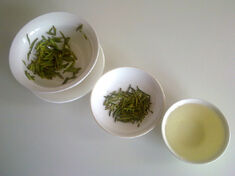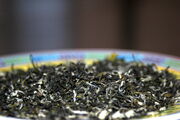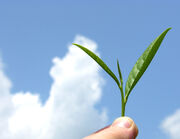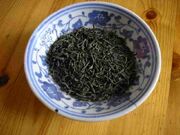- See also Chinese green tea and Green tea at Wikipedia.

The appearance of green tea in three different stages (from left to right): the infused leaves, the dry leaves, and the liquid. Notice that the infused leaves look greener than the dry leaves.

The tea fields in the foothills of Gorreana, Azores Islands, Portugal: the only European region to support green tea production.
Green tea is made from the leaves from Camellia sinensis that have undergone minimal oxidation during processing. Green tea originated in China,[1] but it has become associated with many cultures throughout Asia. Green tea has recently become more widespread in the West, where black tea has been the traditionally consumed tea. Green tea has become the raw material for extracts which are used in various beverages, health foods, dietary supplements, and cosmetic items.[2] Many varieties of green tea have been created in the countries where it is grown. These varieties can differ substantially due to variable growing conditions, horticulture,[3] production processing, and harvesting time.
Over the last few decades green tea has been subjected to many scientific and medical studies to determine the extent of its long-purported health benefits, with some evidence suggesting that regular green tea drinkers may have a lower risk of developing heart disease[4] and certain types of cancer.[5] Although green tea does not raise the metabolic rate enough to produce immediate weight loss, a green tea extract containing polyphenols and caffeine has been shown to induce thermogenesis and stimulate fat oxidation, boosting the metabolic rate 4% without increasing the heart rate.[6]
The mean content of flavonoids in a cup of green tea is higher than that in the same volume of other food and drink items that are traditionally considered of health contributing nature, including fresh fruits, vegetable juices or wine.[7] Flavonoids are a group of phytochemicals present in most plant products that are responsible for health effects such as anti-oxidative and anticarcinogenic functions.[7] However, the content of flavonoids may vary dramatically amongst different tea products.[8]
Varieties[]
- Hunan Province
- 君山银针 Junshan Yinzhen (Silver Needle tea)
- Known as one of the ten most famous Chinese Teas, is one variety of Yellow Tea, like the Huo Mountain Yellow Buds (霍山黄芽) and the Mengding Yellow Buds (蒙顶黄芽). It is cultivated on Junshan Island, Yueyang City, Hunan Province (湖南省,岳阳,洞庭湖君山).
- Zhejiang Province is home to the most famous of all teas, Xi Hu Longjing (西湖龙井), as well as many other high-quality green teas.
- 龙井 Longjing
- Maybe the most well-known green tea in China, originates from Hangzhou (杭州), the capital of Zhejiang Province. Longjing in Chinese literally means dragon well. It is pan-fried and has a distinctive flat appearance. The tasteless frying oil is obtained from tea seeds and other plants.[9] Most of the tea on the market is in fact produced in Sichuan Province and hence is not authentic Longjing, despite many tea producers claims.
- 景宁惠明茶 Huiming
- Named after a temple in Zhejiang.
- 开化龙顶 Kaihua Longding
- A tea from Kaihua County known as Dragon Mountain.
- 华顶云雾 Hua Ding
- A tea from Tiantai County, named after a peak in the Tiantai mountain range.
- 天目青顶 Qing Ding
- A tea from Tian Mu, also known as Green Top.
- 平水珠茶 Gunpowder
- Jiangsu Province

A plate of Bi Luo Chun tea, from Jiangsu Province in China
- 洞庭碧螺春 Bi Luo Chun
- A Chinese famous tea also known as Green Snail Spring, from Dong Ting. As with Longjing, inauthentic Bi Luo Chun is common and most of the tea marketed under this name may, in fact, be grown in Sichuan. One of the key elements of Bi Luo Chun is its processing technique. The leaves, which are young and tender, are hand-picked in early spring to preserve their delicate characteristics. Through a meticulous twisting process, skilled hands carefully shape it into small spiral-shaped granules. This gentle approach allows the leaves to retain their natural flavor and aroma. [10]
- 南京雨花茶 Rain Flower
- A tea from Nanjing.
- originate in Jin Tan city of Jiangsu Province.
- 太湖白云 White Cloud

Camellia sinensis, the tea plant
- Fujian Province is known for mountain-grown organic green tea as well as white tea and oolong tea. The coastal mountains provide a perfect growing environment for tea growing. Green tea is picked in spring and summer seasons.
- 茉莉花茶 Jasmine tea (Mo Li Hua Cha)
- A tea with added jasmine flowers.
- 毛峰 Mao Feng tea
- Meaning "furry peak".
- 翠剑 Cui Jian
- Meaning "jade sword".
- Hubei Province
- Henan Province

An example of a Chinese green tea, called Mao Jian.
- 信阳毛尖 Xin Yang Mao Jian
- A Chinese famous tea also known as Green Tip, or Tippy Green.
- Jiangxi Province
- 珍眉 Chun Mee
- 狗牯 Gou Gu Nao
- A well-known tea within China and recipient of numerous national awards.
- 云雾 Yun Wu
- A tea also known as Cloud and Mist.
- Anhui Province is home to several varieties of tea, including three Chinese famous teas. These are:
- 大方 Da Fang
- A tea from Huangshan also known as Big Square suneet.
- 黄山毛峰 Huangshan Maofeng
- A Chinese famous tea from Huangshan.
- 六安瓜片 Liuan Leaf
- A Chinese famous tea also known as Melon Seed.
- 猴魁 Hou Kui
- A Chinese famous tea also known as Monkey tea.
- 屯绿 Tun Lu
- A tea from Tunxi District.
- 火青 Huo Qing
- A tea from Jing County, also known as Fire Green.
- 雾里青 Wuliqing
- Wuliqing was known since the Song dynasty. Since 2002 Wuliqing is produced again according to the original processing methods by a company called Tianfang (天方). Zhan Luojiu a tea expert and professor at the Anhui Agricultural University who relived its production procedure.
- A medium-quality tea from many provinces, an early-harvested tea.
- Sichuan Province
- 竹叶青茶 Zhu Ye Qing
- Also known as Meng Ding Cui Zhu or Green Bamboo.
- 蒙顶甘露 Meng Ding Gan Lu
- A yellowish-green tea with sweet aftertaste.
References[]

|
This page uses content from Wikipedia. The original article was at Chinese green tea. The list of authors can be seen in the page history. As with WikiTea, the text of Wikipedia is available under the Creative Commons Licence. |
- ↑ “Green Teas: A (very) Brief History”, TeaGuardian.com (Retrieved 2013-10-19)
- ↑ Eike Reich, Anne Schibil, Valeria Widmer, Ruth Jorns, Evelyn Wolfram, Alison DeBatt. “HPTLC methods for identification of green tea and green tea extract,” Journal of Liquid Chromatography & Related Technologies. August 2006. Volume 29, issue 14. Pages 2141-2151. doi:10.1080/15512160600760293 (Retrieved 2013-10-19)
- ↑ “Quality Basics 1: Various Plants, Various Qualities,” TeaGuardian.com (Retrieved 2013-10-19)
- ↑ “Tea & Cardiovascular Health,” TeaGuardian.com (Retrieved 2013-10-19)
- ↑ “Green tea’s cancer-fighting allure becomes more potent,” ScienceDaily.com (2003) (Retrieved 2013-10-19)
- ↑ Dulloo AG, Duret C, Rohrer D, Girardier L, Mensi N, Fathi M, Chantre P, Vandermander J. “Efficacy of a green tea extract rich in catechin polyphenols and caffeine in increasing 24-h energy expenditure and fat oxidation in humans,” American Journal of Clinical Nutrition. Volume 70, issue 6 (1999). Pages 1040-1045. PMID 10584049 (Retrieved 2013-10-19)
- ↑ 7.0 7.1 USDA Database for the Flavonoid Content of Selected Foods, Release 2.1 (2007)
- ↑ “Health Benefits of Tea,” TeaGuardian.com (Retrieved 2013-10-19)
- ↑ “Green Tea Production: Roasting”, TeaGuardian.com (Retrieved 2013-10-19)
- ↑ https://teajewel.com/blogs/news/bi-luo-chun-tea-unraveling-the-timeless-elegance-of-chinas-green-jewel?_pos=2&_sid=e272ad74a&_ss=r
